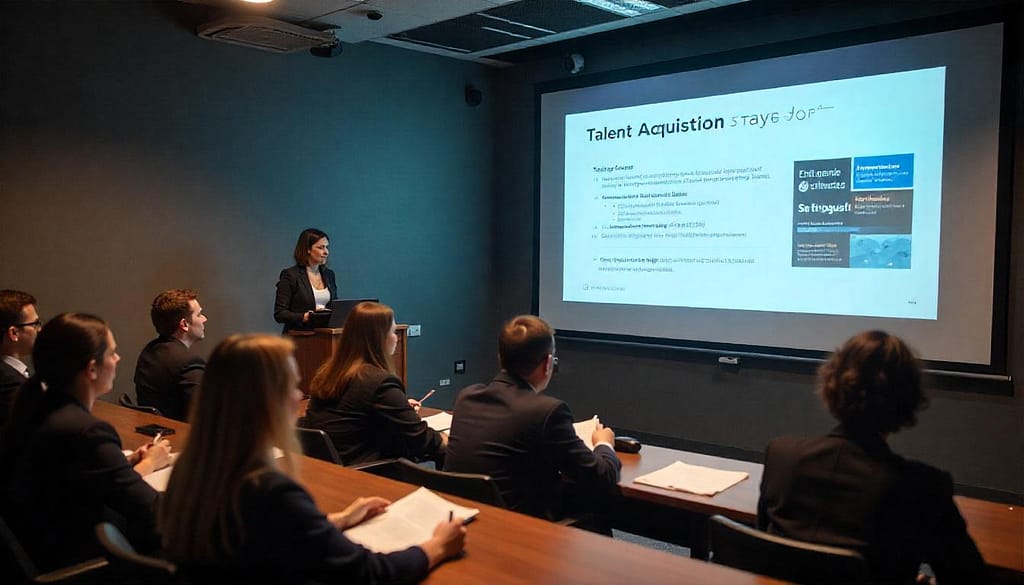Executive Summary
Talent Acquisition Metrics and Analytics play a pivotal role in shaping modern hiring strategies, particularly in dynamic regions like the UAE, Saudi Arabia, Kuwait, and Europe. By leveraging data-driven insights, organizations can optimize recruitment processes, reduce time-to-hire, and improve candidate quality. In today’s competitive job market, understanding key metrics—such as cost-per-hire, time-to-fill, and candidate satisfaction—is essential for making informed decisions. For multinational companies, these analytics help navigate cultural, legal, and logistical challenges while ensuring compliance with local labor laws. This article explores the fundamentals, best practices, and solutions for overcoming common hurdles in Talent Acquisition Metrics and Analytics, providing actionable strategies for HR professionals and business leaders.
Chapter 1: Introduction to Talent Acquisition Metrics and Analytics
Talent Acquisition Metrics and Analytics are transforming how organizations attract, assess, and retain top talent. By measuring critical recruitment KPIs, businesses can identify inefficiencies, predict hiring trends, and align workforce planning with long-term goals. In regions like the UAE and Europe, where labor laws and cultural expectations vary significantly, data-driven recruitment ensures compliance while enhancing candidate experience. For example, the UAE’s Ministry of Human Resources and Emiratisation (MOHRE) mandates strict hiring regulations, making analytics indispensable for avoiding legal pitfalls.
Beyond compliance, Talent Acquisition Metrics and Analytics help organizations assess diversity initiatives, employer branding effectiveness, and sourcing channel performance. A study by SHRM found that companies using advanced analytics reduce hiring bias by 35%. In Europe, GDPR compliance further underscores the need for transparent data handling in recruitment. By integrating these metrics into HR strategies, businesses can foster a competitive edge in global talent markets.
Chapter 2: Best Practices for Talent Acquisition Metrics and Analytics
Detailed Strategies and Methodologies
Effective Talent Acquisition Metrics and Analytics rely on a structured approach. Start by defining clear objectives—whether reducing time-to-hire or improving candidate diversity. Track metrics like source-of-hire effectiveness, offer acceptance rates, and onboarding success. For example, a European tech firm reduced time-to-fill by 20% by analyzing bottlenecks in their interview process.
Another best practice is leveraging predictive analytics to forecast hiring needs. Tools like AI-powered recruitment software can identify patterns in candidate behavior, enabling proactive talent pipelining. Case studies from the UAE show that companies using predictive models achieve 15% higher retention rates.
How Allianze HR Consultancy Helps
- Free Hiring Model: Allianze HR Consultancy eliminates financial barriers for job seekers by charging only employers. This model attracts a wider talent pool while ensuring fair access to opportunities.
- Ethical Sourcing: Allianze partners with vetted agencies in South Asia, adhering to strict compliance standards. From verifying credentials to ensuring fair wages, every step is monitored to uphold ethical recruitment.
Allianze’s expertise extends to regional labor laws, helping clients navigate complex regulations in the UAE, Saudi Arabia, and Kuwait. Their end-to-end recruitment solutions include candidate screening, interview coordination, and relocation support, ensuring seamless hires.

Chapter 3: Common Challenges and Solutions
Implementing Talent Acquisition Metrics and Analytics comes with challenges:
- Data Silos: Disconnected HR systems hinder accurate reporting. Solution: Integrate ATS and HRIS platforms for unified analytics.
- Cultural Misalignment: Hiring for roles in the Middle East requires understanding local norms. Solution: Partner with regional experts like Allianze to assess cultural fit.
- Compliance Risks: Non-compliance with GCC labor laws can result in penalties. Solution: Regular audits and training on local regulations.
- Candidate Drop-Offs: Lengthy hiring processes deter top talent. Solution: Streamline workflows using automation.
- Measuring ROI: Quantifying recruitment success is complex. Solution: Align metrics with business outcomes, such as revenue per hire.
Checklist: Best Practices
- Use job descriptions that respect local laws. In Saudi Arabia, for instance, job ads must comply with Saudi Vision 2030 policies, including gender inclusivity.
- Offer relocation support. Provide housing assistance, visa sponsorship, and cultural training to ease transitions.
- Partner with ethical agencies like Allianze. Look for certifications like ISO 30434 to ensure ethical recruitment practices.
- Use regional keywords in job ads. Terms like “Dubai-based” or “Kuwaiti National Preferred” improve visibility in local searches.
Conclusion
In conclusion, Talent Acquisition Metrics and Analytics are indispensable for modern recruitment. To summarize, businesses must prioritize data integration, compliance, and candidate experience to succeed. Ultimately, adopting these strategies leads to faster hires, lower costs, and higher retention. Five final tips: 1) Audit your metrics quarterly, 2) Invest in predictive tools, 3) Train HR teams on regional laws, 4) Optimize job ads for local SEO, and 5) Collaborate with ethical partners like Allianze.
About Allianze HR Consultancy
Founded in 2016, Allianze HR Consultancy specializes in ethical, zero-cost recruitment across the UAE, India, Nepal, Kuwait, and Saudi Arabia. Their services include executive search, bulk hiring, and onboarding support, backed by a 90% candidate satisfaction rate. With offices in five countries, Allianze combines local expertise with global standards, ensuring compliant and efficient hiring. Testimonials highlight their success in placing 10,000+ professionals in roles ranging from healthcare to engineering. Contact us today to streamline your recruitment needs.


